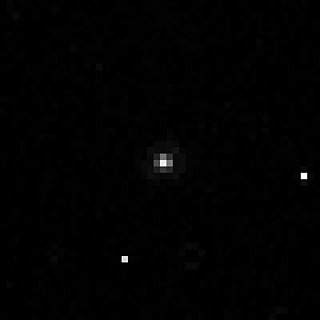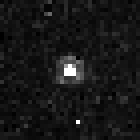385571 Otrera, provisional designation 2004 UP10, is a Neptune trojan leading Neptune's orbit in the outer Solar System. It was discovered by American astronomers Scott Sheppard and Chad Trujillo at Las Campanas Observatory on 16 October 2004. It measures approximately 100 kilometers in diameter and was the second such body to be discovered after 2001 QR322.

(612911) 2004 XR190, nicknamed Buffy, is a trans-Neptunian object, classified as both a scattered disc object and a detached object, located in the outermost region of the Solar System. It was first observed on 11 December 2004, by astronomers with the Canada–France Ecliptic Plane Survey at the Mauna Kea Observatories, Hawaii, United States. It is the largest known highly inclined (> 45°) object. With a perihelion of 51 AU, it belongs to a small and poorly understood group of very distant objects with moderate eccentricities.

(48639) 1995 TL8 is a binary trans-Neptunian object from the scattered disc in the outermost regions of the Solar System. It was discovered by Arianna Gleason in 1995 and measures approximately 176 kilometers in diameter. Its 80-kilometer minor-planet moon, provisionally designated S/2002 (48639) 1, was discovered on 9 November 2002.

(84522) 2002 TC302, prov. designation: 2002 TC302, is a mid-sized trans-Neptunian object located in the outermost region of the Solar System. It was discovered on 9 October 2002, by American astronomers Mike Brown, Chad Trujillo and David Rabinowitz at the Palomar Observatory in California. The resonant trans-Neptunian object stays in a 2:5 resonance with Neptune. It has a reddish color, a rotation period of 56.1 hours and measures at least 500 kilometers (310 miles) in diameter.
(119070) 2001 KP77, provisional designation:2001 KP77, is a resonant trans-Neptunian object in the Kuiper belt, a circumstellar disc located in the outermost region of the Solar System. It was discovered on 23 May 2001, by American astronomer Marc Buie at the Cerro Tololo Observatory in Chile. The object is locked in a 4:7 orbital resonance with Neptune. It has a red surface color and measures approximately 176 kilometers (110 miles) in diameter. As of 2021, it has not been named.
(118228) 1996 TQ66, prov. designation:1996 TQ66, is a resonant trans-Neptunian object of the plutino population in the Kuiper belt, located in the outermost region of the Solar System. It was discovered on 8 October 1996, by American astronomers Jun Chen, David Jewitt, Chad Trujillo and Jane Luu, using the UH88 telescope at the Mauna Kea Observatories, Hawaii. The very red object measures approximately 185 kilometers (110 miles) in diameter. As of 2021, it has not been named.
(118378) 1999 HT11, provisional designation:1999 HT11, is a trans-Neptunian object from the outermost region of the Solar System, locked in a 4:7 orbital resonance with Neptune. It was discovered on 17 April 1999, by astronomers at the Kitt Peak Observatory, Arizona, in the United States. The very red object measures approximately 134 kilometers (83 miles) in diameter. As of 2021, it has not been named.

2006 QH181, also written as 2006 QH181, is a trans-Neptunian object (TNO) in the scattered disc. Its orbit is currently too poorly determined (U=6) to know whether it is in a resonance with Neptune.
(527604) 2007 VL305, provisional designation 2007 VL305, is an inclined Neptune trojan that shares Neptune's orbit in the L4 Lagrangian point. It was discovered on 4 November 2007, by astronomers Andrew Becker, Andrew Puckett and Jeremy Kubica at the Apache Point Observatory in New Mexico, United States, although images from 2005 have also been recovered. It measures approximately 160 kilometers in diameter and was the sixth Neptune trojan to be discovered. As of 2016, it is 34.1 AU from Neptune.

(308933) 2006 SQ372 is a trans-Neptunian object and highly eccentric centaur on a cometary-like orbit in the outer region of the Solar System, approximately 123 kilometers (76 miles) in diameter. It was discovered through the Sloan Digital Sky Survey by astronomers Andrew Becker, Andrew Puckett and Jeremy Kubica on images first taken on 27 September 2006 (with precovery images dated to 13 September 2005).

(612584) 2003 QX113 is a large trans-Neptunian object from the scattered disc located in the outermost region of the Solar System. It is one of the most distant objects from the Sun at 60.5 AU. It was discovered by astronomers with the Canada–France Ecliptic Plane Survey at Mauna Kea Observatories, Hawaii, when it was near aphelion on 31 August 2003. It was provisionally designated 2003 QX113.

(82075) 2000 YW134, provisional designation: 2000 YW134, is a resonant trans-Neptunian object and binary system, located in the outermost region of the Solar System. It was discovered on 26 December 2000, by astronomers with the Spacewatch survey at Kitt Peak Observatory near Tucson, Arizona. The reddish object stays in a rare 3:8 resonance with Neptune. A smaller companion was discovered by the Hubble Space Telescope in October 2002. As of 2021, neither the primary body nor its satellite have been named.

(528381) 2008 ST291, provisional designation 2008 ST291, is a 1:6 resonant trans-Neptunian object located in the outermost region of the Solar System that takes almost a thousand years to complete an orbit around the Sun. It was discovered on 24 September 2008 by American astronomers Megan Schwamb, Michael Brown and David Rabinowitz at the Palomar Observatory in California, with no known earlier precovery images.

(432949) 2012 HH2 is a resonant trans-Neptunian object, approximately 255 kilometers (160 miles) in diameter, located in the outermost region of the Solar System. It was discovered by Slovak astronomer Tomáš Vorobjov from images taken on the night of 19 April 2012, at the Astronomical Research Institute (H21) in Illinois, United States. This minor planet was numbered (432949) by the Minor Planet Center on 4 April 2015 (M.P.C. 93615). As of 2021, it has not been named.
(523671) 2013 FZ27, provisional designation 2013 FZ27, is a trans-Neptunian object located in the Kuiper belt in the outermost region of the Solar System, approximately 570 kilometers (350 miles) in diameter. It was discovered on 16 March 2013, by American astronomers Scott Sheppard and Chad Trujillo at the CTIO in Chile. Numbered in 2018, this minor planet has not been named.

(523794) 2015 RR245, provisional designation 2015 RR245, is a large trans-Neptunian object of the Kuiper belt in the outermost regions of the Solar System. It was discovered on 9 September 2015, by the Outer Solar System Origins Survey at Mauna Kea Observatories on the Big island of Hawaii, in the United States. The object is in a rare 2:9 resonance with Neptune and measures approximately 600 kilometers in diameter. 2015 RR245 was suspected to have a satellite according to a study announced by Noyelles et al. in a European Planetary Science Congress meeting in 2019.
(574372) 2010 JO179, provisional designation: 2010 JO179, is a large, high-order resonant trans-Neptunian object in the outermost regions of the Solar System, approximately 700 kilometers (430 miles) in diameter. Long-term observations suggest that the object is in a meta-stable 5:21 resonance with Neptune. Other sources classify it as a scattered disc object. It is possibly large enough to be a dwarf planet.
(495603) 2015 AM281, provisional designation 2015 AM281, is a resonant trans-Neptunian object in the outermost region of the Solar System, guesstimated at approximately 470 kilometers (290 miles) in diameter. It was discovered on 13 March 2010, by astronomers with the Pan-STARRS survey at Haleakala Observatory, Hawaii, United States.
2015 FG415 is a trans-Neptunian object from the scattered disc, located in the outermost region of the Solar System. It was discovered on 17 March 2015, by American astronomer Scott Sheppard at the Mauna Kea Observatories, Hawaii, and received the provisional designation 2015 FG415. As of 2021, it is the 9th-most-distant object from the Sun at 87.2 AU and measures approximately 280 kilometers (170 miles) in diameter.
2014 UE228 is a trans-Neptunian object from the outermost region of the Solar System. The object is in a rare 3:8 resonance with Neptune and measures approximately 93 kilometers (58 miles) in diameter. It was first observed on 22 October 2014, by astronomers with the Outer Solar System Origins Survey at the Mauna Kea Observatories, Hawaii, and was provisionally designated 2014 UE228. As of 2021, it has not been numbered.










